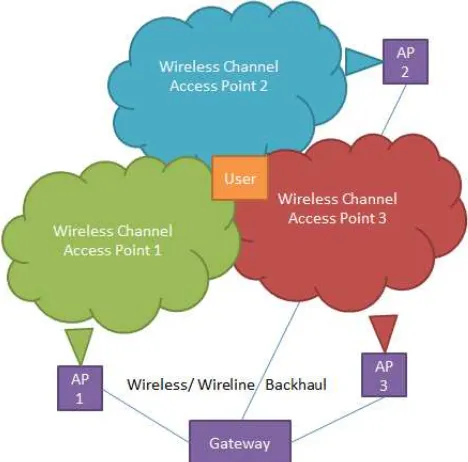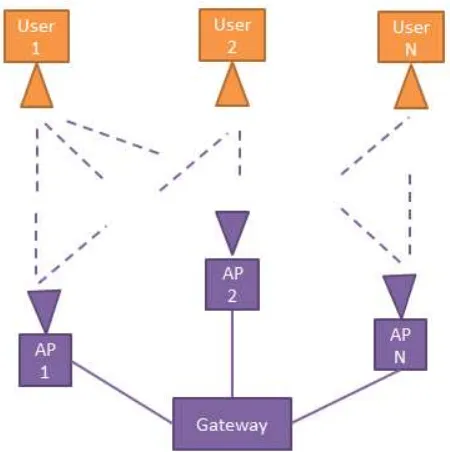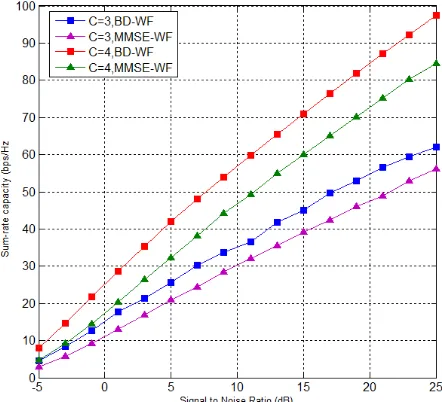Journal of Electrical Technology UMY (JET-UMY), Vol. 1, No. 1, March 2017 ISSN 2550-1186
Interference Coordination using Precoding Schemes
for Indoor Hotspots
Toha Ardi Nugraha
Department of Electical Engineering, Faculty of Engineering Universitas Muhammadiyah Yogyakarta
Kampus Terpadu UMY, Jl. Lingkar Selatan, Kasihan, Bantul, Yogyakarta 55183 e-mail: toha@ft.umy.ac.id
Abstract – This paper investigates an interference coordination method for indoor hotspot deployment which includes cooperative communication between access points. Coordination between indoor hotspots access point with a method of coordination strategy is used by using of multiple-input multiple-output (MIMO) antennas technique. In order to achieve the capacity, some preceding technique is implemented in MIMO such as Minimum Mean Square Error (MMSE) and Block Diagonalization (BD). MMSE and BD precoding is used to coordinate the transmissions across multiple antenna in transmitter and receiver in case of multiple antenna transmissions. Water-Filling (WF) power allocation is also implemented in this scheme. This schemes is proposed to mitigate inter user interference. Based on the simulation, the results show that coordination scheme in indoor hotspots deployment using BD pre-coding demonstrates a higher data rate than MMSE. The achievable sum rate of hotspot with coordination three access points using BD better around 5 Bps/Hz compared to MMSE method in the same cases.
Keywords: Wireless, Hotspots, Cooperative Communication, MIMO, Precoding
I.
Introduction
Today, wireless indoor data traffic is growing faster than outdoor since user relatively stays in building areas. Indoor data traffic is predicted to increase even more because of evolution of various new technologies such as implementation of
Device-to-Device communication (D2D) or
Machine-to-Machine (M2M) communication in 5G
(Generation) technology [1]. The large
implementation of wireless indoor could be one of the best choices of service providers to solve the demand of data traffic in indoor in case of high density indoor area.
In some cases, wireless indoor access point can be a way to connect user devices to internet access therefore it can communicate to the internet networks using the concept of hotspots technology
and optical fiber as backhaul [2]. The
implementation of hotspots can be placed using high-precision location to solve in different of
typical indoor buildings. The main usage of hotspot is because of the poor signal issues in several typical indoor areas, e.g., hotel or mall especially in
underground parking areas, elevators and
basements etc.
The implementation of indoor hotspot became more effective as the service provider started to see its benefits, i.e., user data traffic offloading from outdoor, additional channel and increased data rates etc. Therefore, the implementation of large hotspot could be easily implemented the cooperative
communication systems. The cooperative
communication system uses a concept of wireless small cells [3]. A gateway is as a central of several hotspots. This coordination scheme is to coordinate and determines the resource allocation (such as time, frequency, and code) between the wireless access points (APs) as shown in Fig.1.
T. A. Nugraha
of cooperative communications is several nodes on wireless network which can make help each other coordination such as deliver channels from several antennas and access point. This scheme is used to achieve the high data rate of communication by using spatial diversity antenna or increase data traffic through spatial multiplexing antenna. The other solution to improve data traffic is by implementing multiple antennas technique (MIMO) [5]. The multiple antennas technique is that the time-frequency resources in its antenna channel can be sent directly to a number of active users. In antenna MIMO, precoding technique is an important thing to guarantee orthogonally across parallel channels.
In MIMO, there are two kind of precoding techniques can be implemented, that is liner and non-linier precoding. In [6], non-linear pre-coding scheme (e.g., Blog Diagonalization (BD) and dirty paper coding (DPC)) gave better performance than linear pre-coding techniques (e.g., Minimum Mean Square Error (MMSE), Channel Inversion (CI), Regular Channel Inversion (RCI). DPC scheme is not suitable to be implemented in practical use due to the requirement of infinitely long code words and codebooks.
One of the approaches to be implemented in wireless networks is BD which can supports by implementing some multiple stream transmissions. BD is one of the practical pre-coding techniques which can eliminates the inter-user interference in downlink transmission of MIMO systems [3]. Therefore, this work proposes coordination several wireless indoor hotspots by implementing MIMO antenna technique. Coordination antenna indoor hotspot using BD precoding can minimize interference between users and between access points.
The paper is organized as follows. Related works are described in the next section. Third section is the coordination methods. Fourth section is the evaluation based on the simulations, followed by interference coordination, power allocation and simulation result. Finally, the conclusion is described in last section.
II.
Related Works
In wireless system, several access point in a wireless network uses different set of resource allocation from the other access point to avoid inter access point interference. Since the limitation of
frequency spectrum, implementing the same frequency is one of the best solutions to the service provider.
[image:2.595.309.543.231.462.2]The authors in [7], the paper has proposed interference management by using fractional frequency reuse to guarantee the performance of the users, especially in cell edge regions. Since FFR can only manage interference between wireless frequency, channel user interference problems cannot be solved by this schemes.
Figure 1. Coordination Scheme between Acess Points using Gateway
Another method to manage inter user interference is implementing base station coordination. This scheme has been offered as a solution to manage user interference in downlink transmission using coordination between multi access point networks [8]. This method can share information across base station or access point and generate downlink signals with cooperatively.
T. A. Nugraha
The maximum achievable rate in a coordinated network with ZF and DPC has been proposed in [10], which showed a gain over conventional single antenna transmission. By simplifying network models, analytical results were derived for multi-cell ZF beam-forming in various coordination strategies with grouped cell interior and edge users in.
[image:3.595.60.285.407.633.2]One of the best approaches in cooperative MIMO channel is by implementing BD precoding. BD is a more practical precoding scheme for MIMO broadcast channels. BD provides each user with coordination to manage inter-user interference by allocating channel with properly designed linear pre-coding matrices. In addition, it was shown in [3] that BD precoding will improve the sum capacity in a wireless system. BD is known as a practical pre-coding technique that eliminates inter-user interference in downlink multiinter-user MIMO systems. Therefore, this paper implements BD precoding technique in several access point as hotspot networks for managing interference between access point.
Figure 2. Coordination scheme between access point using MIMO with number of receiver Nr = 2 and number
of transmitter Nt = 2
III.
Coordinated Indoor Hotspots
This coordination scheme considers several hotspots that having Nt transmit antennas and uj
user j=1… N, and Nr is a number of antenna
receiver. This research assumes there is no packet delay in the communication transmission link between access point and the gateway.
III.1. Coordination Scheme
The coordination stage for indoor coordination hotspot is proposed by three stages:
Stage 1 - user uj is identified to stay longer in
the edge coverage of an access point. The user in the corner is pre-allocated to the channel H user uj
without considering their instantaneous wireless channel quality, therefore it can be more problem to other access point coverage or it can make inter access point interference from neighbor coverage.
Stage 2 - Coordination between access point in wireless indoor hotspots can be shown as follows. The total number of transmit antennas can be written by
, 1 C
t t i
i
N n
(1)where C is the number of hotspots with
coordination of access point which as a serving coverage and neighbor access point. In receiver side, the total number of receiver antennas can be seen as a set of active user uj are given by
, 1
j j N
r r u
u
N n
(2)The channel matrix from coordination between hotspots to user uj is given by
1
...
j j j
C
u u u
H
H
H
(3)where C is the number access point with
coordination scheme, and the channel matrix by implementing MIMO system for user uj given by
1...
j
H
H H
u u N
H H H (4)
T. A. Nugraha
,
1 1
j j j j j n n j
n u j
C C
i i i i i i
u u u u u u u u
i i
N
u
y
H w u
H
w u
n
(5) where j i uH
is the hotspot-i channel matrix from touser uj,
,
n n n u j
i i u u u N
w u
indicates the inter access pointinterference experienced by user uj, n i u
w
can be seenin the next subsection, and
n
uj is Gaussian Noisecomplex entries with zero-mean and
n2 as variances.This stage is to ensure that the gain over the
several coordinated multi access point is
implemented by using BD precoding. This step is to set Si….N, with S is the available access point for
serving the users and N is the number of neighbor access points.
Therefore, in instance of all neighbor access points assist the users, it mean that C = Si….N. To
complete this stage, channel state information (CSI) is informed to the server.
Stage 3 - In order to conform that the hotspots performance gain is obtained without reducing the overall networks performance. In this stage, inter user interference is implemented by employing BD pre-coding matrix. This scheme is applied into Eq.5.
III.2. Interference Coordination
As mentioned in above, BD precoding is one of the efficient methods for mitigating interference between user and also between access points.
Therefore, received signal users
j u
y
based on theEq. 1, for the user uj with BD precoding that it can
be called with the perfect CSI, the received signal should be
1
j j j j j
C
i i i
u u u u u
i
y H w u n for all j n
(6)In order to get
j i u
w
, at first it must define *j u
H
as follows
*1 ... 1 1 ...
j j j
H H H
H H
u u u N
H H H H H
(7)
The antenna of MIMO systems can be decomposed into the parallel channel with non-interference spatial layers.
The effective of channel matrix can be obtained as follows
* * *
,
*(1) *(0)
( ) 0
j j j
j j
u u m u
H
u u
SVD H U
V V
(8)where *,
j m u
is the diagonal matrix from mimochannel, in which non-zero elements devote of
sub-channel’s gain. Then, *(1)
j u
V
and *(0)j u
V
are composedto the right vectors which corresponding to non-zero singular values and non-zero singular values, respectively.
III.3. Water Filling
This paper uses water filling power allocation algorithm in order to serve each of active users. The number of power like water or as imagination of power allocation is given to the channel based on the signal to noise ratio (SNR) of the channel condition, based on CSI. This power allocation method is better compare to the other, in case of the other scheme compared to equal-power in wireless network [3].
This power allocation method was already implemented in [3][12]. The optimal power allocation by implementing indoor propagation
model (Cost 231 MWL –Indoor Model) on the
hotspots can be investigated as follows
2 2 2
1 1 j j N u c u
j j j
P P
PLu N PLu PLu
(9)where
P
c is coordinated power of wireless indoorhotspots and PLuj as loss-propagation of wireless
indoor for user uj.
Finally, formula below is an equation to get the
achievable sum rate capacity with
R
ujfor the useruj under the Additive White Gaussian Noise
T. A. Nugraha
* ,
2 2
*log 1 j j
j
u m u u
P
R B
(10)
TABLEI SIMULATION PARAMETER
Parameter Value
Network layout Hotspots network
Frequency 2.4 GHz
Wireless indoor radius 30m
Number of Transmitter 2 antennas
Number of Receiver 2 antennas
Maximum Transmit Power 20 dBm
Propagation Model Cost 231 Multi Wall
IV.
Simulation Result
Simulations are investigated by using
[image:5.595.50.293.68.293.2]coordination several wireless using the number of cooperative wireless with number of access point with 2, 3, and 4 access points. This paper assumes that the access point users are randomly placed within the overlapping of the coverage of access point. This simulation is also investigated with comparison non-coordination and coordination hotspot. The total number of access point transmitter antennas is equal or greater than the total number of receiver antennas (Nt ≥ Nr), this condition is required by BD precoding.
Figure 3. Single Acess Point with Equal Power (EP)
[image:5.595.318.528.75.282.2]and Water Filling (WF)
[image:5.595.317.538.325.526.2]Figure 4. Coordinated indoor using BD dan MMSE
Figure 5. Coordinated Acess Points with BD-EP compare to BD-WF
Fig.3 and Fig.4 informs the comparison between hotspot using non-coordinated and coordination access points. As expected, the sum rate capacity performance of the indoor networks can be improved by implementing the concept of cooperative communication compare to single small cell. It can be seen that when power allocation using water-filling (WF) algorithm using BD is better compare with the equal power (EP) allocation.
[image:5.595.68.281.528.722.2]T. A. Nugraha
precoding with water filling power allocation (MMSE-WF) methods. The reason is that inter user interference in MMSE cannot be removed completely because of the noise power even using water filling. It can be seen that the achievable sum rate in MMSE also tends to improve with increasing size C as the number of access point. However, by using BD, since it can mitigate inter user interference between access points, the achievable sum rate is better than MMSE with same cases. For example, the achievable sum rate of hotspot with C=3 in BD, with SNR 20 dB, better about 5 bps/Hz compared to MMSE method with the same cases.
V.
Concussion
This paper describes the implementation of coordinated access point wireless indoor with Block Diagonalization (BD) precoding and water filling (WF) power allocation. By the simulation result, the coordinated wireless with BD-WF informed good sum rate capacity compare to MMSE-WF precoding. This coordination schemes is proposed to mitigate interference between users and also between access points in indoor area. Based on the simulation, the results show that coordination scheme in indoor hotspots by using BD-WF precoding demonstrates a higher data rate compare to MMSE-WF. The achievable sum rate of hotspot with coordination four access points using BD-WF better around 10 Bps/Hz compared to MMSE-WF method in the same cases.
References
[1] Chen, S., & Zhao, J. (2014). The requirements, challenges, and technologies for 5G of terrestrial mobile telecommunication. IEEE Communications Magazine, 52(5), 36-43.
[2] Wang, K., Nirmalathas, A., Lim, C., & Skafidas, E. (2011). High-speed optical wireless communication system for indoor applications. IEEE Photon. Technol. Lett., 23(8), 519-521.
[3] Shin, S. Y., & Nugraha, T. A. (2013). Cooperative water filling (coopwf) algorithm for small cell networks. In ICT Convergence (ICTC), 2013 International Conference on (pp. 959-961). IEEE. [4] Chu, X., López-Pérez, D., Yang, Y., & Gunnarsson,
F. (Eds.). (2013). Heterogeneous Cellular Networks: Theory, Simulation and Deployment. Cambridge University Press.
[5] Wang, C. X., Hong, X., Ge, X., Cheng, X., Zhang, G., & Thompson, J. (2010). Cooperative MIMO channel models: A survey. IEEE Communications Magazine, 48(2).
[6] Shin, S. Y., & Nugraha, T. A. (2014). Effect of Channel Estimation Error on Coordinated Small-Cells with Block Diagonalization. In Applied Mechanics and Materials (Vol. 556, pp. 4501-4504). Trans Tech Publications.
[7] Marzetta, T. L. (2010). Noncooperative cellular wireless with unlimited numbers of base station antennas. IEEE Transactions on Wireless Communications, 9(11), 3590-3600.
[8] Dahrouj, H., & Yu, W. (2010). Coordinated beamforming for the multicell multi-antenna wireless system. IEEE transactions on wireless communications, 9(5).
[9] Wang, Q., Debbarma, D., Cao, Z. Z., Niemegeers, I., & de Groot, S. H. (2015). Performance Analysis of Large Centralized and Distributed MU-MIMO Systems in Indoor WLAN. In European Wireless 2015; 21th European Wireless Conference; Proceedings of (pp. 1-6). VDE.
[10] F. Kaltenberger, M. Kountouris, L. Cardoso, R. Knopp, and D. Gesbert (2008), “Capacity of linear multi-user mimo pre-coding schemes with measured
channel data,” in Signal Processing Advances in Wireless Communications, 2008. SPAWC 2008. IEEE 9th Workshop
[11] Ng, C. T., & Huang, H. (2010). Linear precoding in cooperative MIMO cellular networks with limited coordination clusters. IEEE Journal on Selected Areas in Communications, 28(9), 1446-1454. [12] Pal, S. K., Nugraha, T. A., Shams, S., & Rahman, A.
(2014). Resource Allocation Strategy using optimal power control for mitigating two-tier interference in heterogeneous networks. In Wireless Communications and Networking Conference Workshops (WCNCW), 2014 IEEE (pp. 104-109). IEEE.


